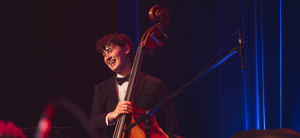Putting your data into action is a vital step in any evaluation plan. We sat down with Anouska Phizacklea – director at the Monash Gallery of Art (MGA) – to discuss how the gallery has harnessed the data they have been collecting.
MGA has been using Culture Counts for the past 18 months, most recently to evaluate their successful exhibitions Dombrovskis: journeys into the wild and Swell by Katrin Koenning. In this time, MGA’s evaluation strategy has become increasingly valuable in generating insights to inform organisational change.
According to Anouska, these insights speak to the multitude of benefits and practical uses of their data, from celebrating the work of MGA staff to effectively utilising all audience feedback – both negative and positive.
Can you tell us a little about MGA and how you aligned your evaluation plan with the gallery’s strategic objectives?
The Monash Gallery of Art is Australia’s home of photography. The gallery champions Australian photography and its artists and inspires people to embrace the art form.
From the outset, we made an effort to align our evaluation plan to MGA’s strategic plan. It was all about measuring the things we needed to measure which allowed us to determine if we were achieving our mission, vision, goals and initiatives at MGA.
How has your evaluation strategy developed over time?
Surveys hadn’t been done at MGA since 2014, so in the beginning, what I needed was baseline data to really understand core demographics. I needed to know how people got to MGA, their ages and overall demographics so we could begin to understand our current audience.
Once getting a hold of quantitative data, we wanted to understand the quality impact of programming because that is the most important. For Culture Counts, that’s something they measure which a lot of other providers don’t, especially given their understanding of the arts and culture sector. This qualitative aspect has been really transformative – without it, feedback would generally be anecdotal – ‘yeah I really loved that exhibition’, but you can’t measure that, use it in a report or tell donors.
What has the data taught you, and how do you intend to use it?
First of all, the data celebrates what my team does. To be able to go to them and say ‘look at how many people are connecting with what you do’ is amazing, because that’s why we’re here. We are here to connect people to the arts. To have the vast majority of people coming through our door connecting to what we do, getting it, and feeling an emotional connection to it, is the most beneficial.
In terms of advocating, we are able to prove what we know anecdotally, and actually say “here’s the hard data”. This goes for demographics and types of programs. For instance, we hold an exhibition targeted at students – our data proves that students are actually coming and positively responding to the exhibition. For me now, we can actually say categorically that what we believe we knew was correct.
It’s also interesting to have feedback in areas where you believed a certain audience segment would respond to, and they didn’t. I’m always telling my team ‘you need feedback. Feedback is good. Positive and negative’. You need to think about it rationally – not everyone is going to like a certain type of art, and that’s okay. These blockages encourage us to understand why someone isn’t resonating or connecting with a program, so that next time we can try a different point of engagement or approach.
How do you plan to tailor your evaluation strategy for future programs at MGA?
At the moment we’re developing audience segments for the organisation – the Culture Counts surveys have informed this segmentation. This has also informed our programming, for example, understanding what people actually want and need in public programs. Now we know what particular audiences will want and respond to. It’s worked really well.
MGA represents a broader local community place to come together, featuring your gallery, sculpture park and library. How have you used your evaluation to inform you in tailoring your community and engagement programs?
While in the first year it was all about demographics and trying to get a baseline of responses across exhibitions and target audiences, we’ve now changed it. We are now asking more questions about value. We approach this by posing interesting questions – trying to get conversations started about different things. These questions get us interesting answers to actually kick-start something so that we can respond, augment and grow.
We are also asking fun questions – we recently asked ‘what would be your dream exhibition at MGA?’. The responses were really interesting and really aligned with the exhibition they attended. The people who came to that exhibition hit a certain audience segment and a lot of their responses were similar, so that was affirming, whilst giving us a direction about what will resonate with them in the future.
From audiences providing feedback on accessibility issues to the types of programs we do, the insights from the Culture Counts data have been heavily incorporated into our thinking at MGA. It’s all about how to engage with your audience better and meet their needs which is so important.
Want to hear more about how you can become a learning organisation? Join us at Thursday 27 June, 12.00pm AEST for ‘Reflect for Success: Becoming a Learning Organisation’.
This webinar will be hosted by Culture Counts Client Director Alison Lasek in conversation with Squirrel Main, Research and Evaluation Manager at the Ian Potter Foundation. Register here.
Image: Lydia Wegner Bathroom Red 2019 from the series Boyd House Constructs, archival inkjet print




